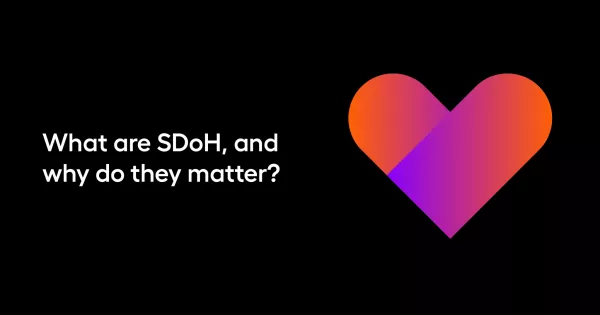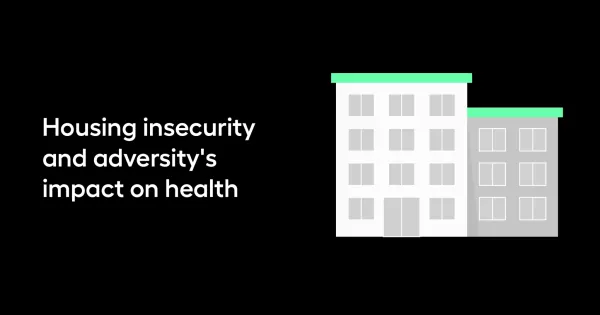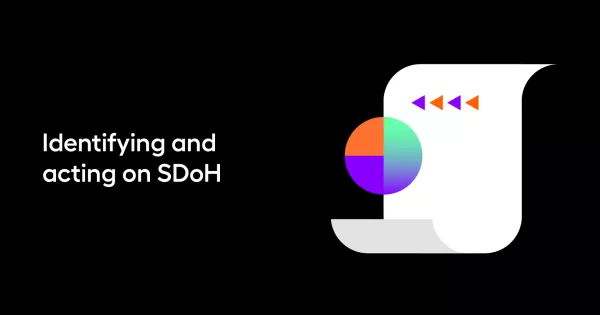The profound impact of SDoH on overall health
Exploring social determinants of health and how they’re shaping healthcare
When it’s coherent and organized, data tells a story. It’s Executive Director of Customer Insights Jacob Hochberg‘s job to find and follow that narrative. As he combed through aggregated records and statistics from healthcare organizations across the country, he discovered a pattern that was both troubling and significant — social determinants of health, like economic insecurity or inadequate housing, raised the likelihood of numerous other conditions, from hypertension to depression.
It’s an unfortunate reality, but data reveals correlations so strong they’re practically neon-lit, like arrows pointing towards a cliff. Below, we explore what social determinants of health are, why they’re difficult to track, and why it’s imperative to consider them in a clinical setting.

What are social determinants of health, and why do they matter?
Social determinants of health are, in a nutshell, the conditions in which people live and work. Think: what they do all day, how they get there, and where they sleep at night. These factors remind us that people aren’t contained in tidy intake checklists — one part of someone’s life influences another.
In healthcare, social determinants of health are often broken down into discrete categories, like environmental determinants of health, psychological determinants of health, and socioeconomic determinants of health. Arcadia’s platform identifies and codes 12 distinct issues across the SDoH categories, like access to transit, educational opportunities, and social adversity.
When Hochberg explored the effects of housing insecurity, it became clear why providers should know and record this information in a clinical setting.

Housing insecurity and adversity’s impact on health
Hochberg and his team’s data visualization on the correlations between housing insecurity and medical ailments illustrates the scale of the issue. Social determinants of health swell a person’s risk for all manner of conditions, from depression to congestive heart failure.
“One thing that we found when we went to put this together is that patients who are housed versus unhoused have really significant variance in terms of their medical conditions as well as behavioral health conditions,” Hochberg says.
“We saw that the prevalence of hypertension was four times higher for patients who are housing insecure versus those who are housed. So specifically, we can see that about 12% of the housed population had hypertension, while about 45% of patients with housing insecurity have hypertension.”
That means patients with housing insecurity face a four times higher likelihood of this life-threatening condition, and through the lens of population health, it means entire communities in peril.
An already bleak statistic is compounded by financial discrepancies. Unhoused patients spent over $700 per member per month on emergent medical admissions, compared to just around $80 per member per month for the rest of the people Hochberg’s team studied. That’s eight times more spent on inpatient admissions for pressing medical issues, and there were also large disparities for the use of ambulances and observation stays.

Identifying and acting on social determinants of health
Convincing administrators and providers that social determinants of health are one of modern medicine’s greatest hurdles is easy — you can’t argue with a massive, replicable data set. But identifying patients who experience SDoH disadvantages is a different story, and resolving those issues is an unprecedented challenge in medicine.
There are no lab tests or physical examinations that reveal recent job loss or the threat of eviction. In Arcadia’s study of four different healthcare systems’ Medicaid populations, only 884 participants had an SDoH factor indicated by an ICD code, whereas assessments at point of care revealed 1,607 members.
Clearly, there’s opportunity in the provider-patient interaction, and a few questions could be the difference between undetected suffering and proactive care.
“If a patient sees their provider, they’re asked, ‘How many times did you go to bed hungry in the last month or last week,'” Hochberg explains. “Then, we can take their answer and flag them as food insecure across our product. We can also do assessments within Arcadia’s products, in the Care Manager suite. This entails proactive outreach, and then that information is combined in our system with point of care surveys.”
Once this information (plus ICD codes from claims and clinical systems) goes into Arcadia’s platform, it’s mapped across 12 distinct categories of social determinants of health. Simultaneously, we track utilization — are patients coming in to see their providers? — along with pre-built workflows to identify at-risk members.

Taking next steps to better population health
To test the efficacy of our platform, we worked with a partner organization in the Pacific Northwest to measure the difference between how many at-risk patients could be identified with assessments versus ICD codes alone.
“ICD codes are not widely adopted for SDoH,” Hochberg says, “so it’s a little bit hard to use just that to reliably identify patients with social concerns.”
Even though ICD codes flagged some patients with housing insecurity, the assessment-based approach cast the widest, most informative net. By having a conversation, providers identified patients with food insecurity, social adversity, employment insecurity, and transportation issues. This wouldn’t have been captured otherwise, relying solely on an EHR or claims-based system.
Together, this wealth of information forms a more nuanced, bigger picture. Members with a housing concern tended to visit emergency departments five times more in the calendar year than those without. Patients facing social adversity had a six times higher cost per patient per month than those without.
“If we put this all together, you have the ability to identify members when they show up at a provider’s practice,” Hochberg explains. “You have the ability to proactively outreach to members, and you have the ability to see if a physician coded using this approach. Essentially, everybody we identify where the social concern is either self-reported or coded directly by a physician accurately identifies members who could use extra support.”

A single source for SDoH data that inspires action
The numbers might speak for themselves, but they paint a picture of communities suffering in silence. Social problems aren’t fenced off from medical ones — they’re in a tangled relationship, and data provides a clearer view of what factors might precipitate a healthcare crisis.
Armed with Arcadia’s knowledge and data, healthcare networks can take a proactive step towards prevention, treatment, and healthier lives for all.

